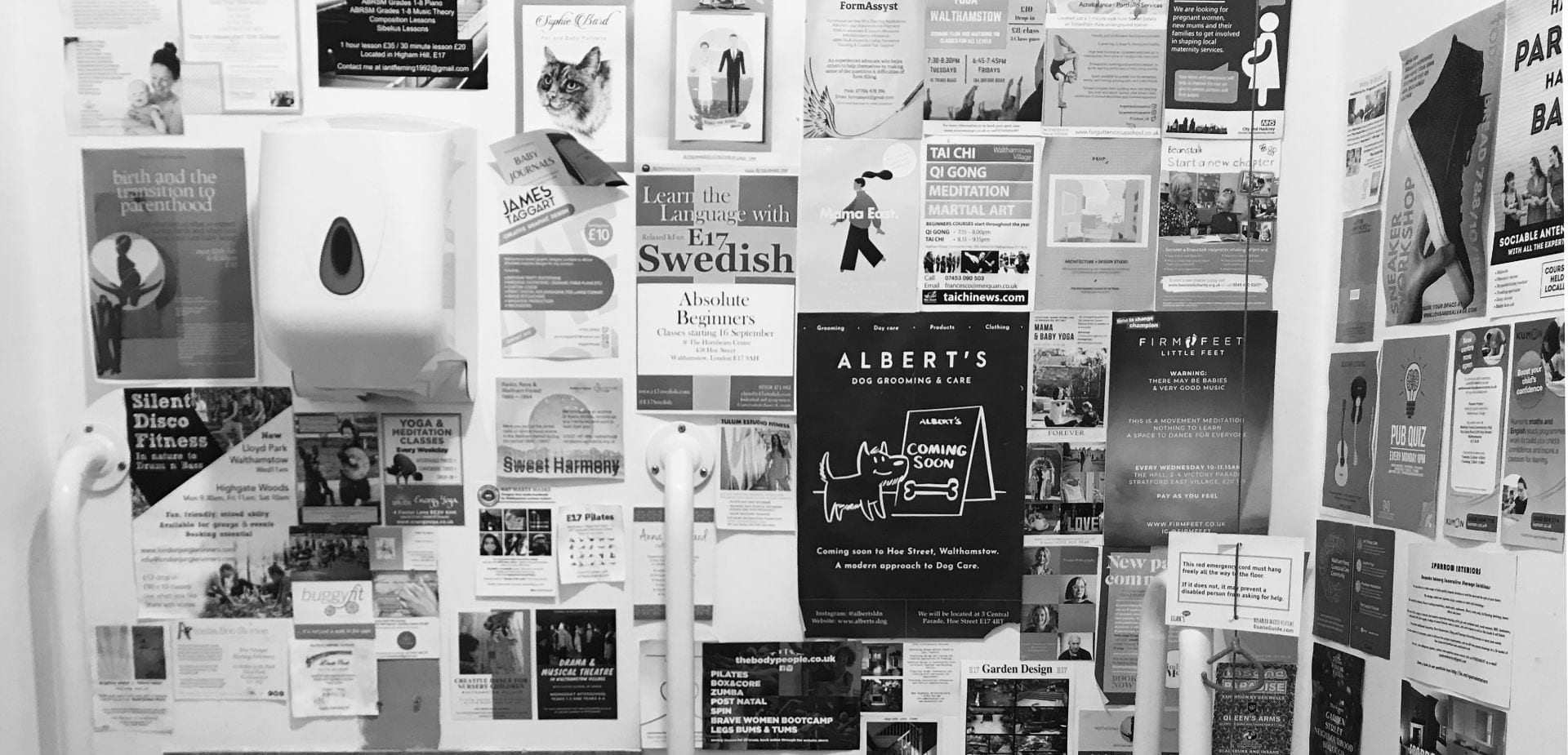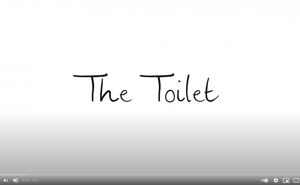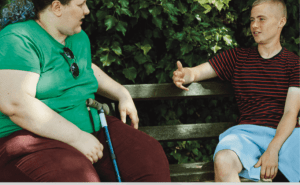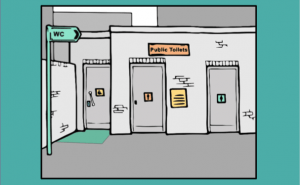Find published information on toilet design. Our resource bank includes guidance, standards, regulation, toolkits, websites and research. Resources can be filtered by type or subject area, using the keywords shown.
We love hearing about other resources that you have found useful! Please send us details via this form.
The RCA is not responsible for the content of external websites.
Keyword
Type
Troubling school toilets: resisting discourses of ‘development’ through a critical disability studies and critical psychology lens
- Author/s:
- Jen Slater, Charlotte Jones, Lisa Procter
- Summary:
- This paper, in Discourse: Studies in the Cultural Politics of Education, interrogates how school toilets and ‘school readiness’ are used to assess children against developmental milestones. Such developmental norms both inform school toilet design and practice, and perpetuate normative discourses of childhood as middle-class, white, ‘able’, heteronormative, cissexist and inferior to adulthood.
- Web link:
- Go to resource
- Publication date:
- 2019 [et_pb_section fb_built="1" _builder_version="4.8.2" _module_preset="default" background_color="rgba(229,229,229,0.52)" custom_margin="50px||50px||false|false" border_radii="on|15px|15px|15px|15px" box_shadow_style="preset4" box_shadow_spread="-3px" box_shadow_color="#f15a62" locked="off"][et_pb_row admin_label="Row" _builder_version="4.8.2" _module_preset="default" custom_margin="auto|50px|0px|50px|false|false"][et_pb_column type="4_4" admin_label="Column" _builder_version="4.8.2" _module_preset="default"][et_pb_text _builder_version="4.8.2" _module_preset="default"]Troubling school toilets: resisting discourses of 'development' through a critical1
- Keywods:
- GenderInclusion
- Type:
- Academic Paper
The toilet debate: Stalling trans possibilities and defending ‘women’s protected spaces’
- Author/s:
- Charlotte Jones, Jen Slater
- Summary:
- As one of the few explicitly gender-separated spaces, the toilet has become a prominent site of conflict and a focal point for ‘gender-critical’ feminism. In this article for The Sociological Review, we draw upon an AHRC-funded project, Around the Toilet, to reflect upon and critique trans-exclusionary and trans-hostile narratives of toilet spaces.
- Web link:
- Go to resource
- Publication date:
- 2020 [et_pb_section fb_built="1" _builder_version="4.8.2" _module_preset="default" background_color="rgba(229,229,229,0.52)" custom_margin="50px||50px||false|false" border_radii="on|15px|15px|15px|15px" box_shadow_style="preset4" box_shadow_spread="-3px" box_shadow_color="#f15a62" locked="off"][et_pb_row _builder_version="4.8.2" _module_preset="default" custom_margin="auto|113px|0px|50px|false|false"][et_pb_column type="4_4" _builder_version="4.8.2" _module_preset="default"][et_pb_text _builder_version="4.8.2" _module_preset="default"]The toilet debate: Stalling trans possibilities and defending 'women's protected spaces' Author/s:1
- Keywods:
- GenderInclusion
- Type:
- Academic Paper
The Toilet
- Author/s:
- Around the Toilet (Sheffield Hallam University)
- Summary:
- This quirky animation weaves together personal accounts from transgender, disabled and Muslim people, who share the trials and tribulations of accessing and using public toilets in a society where some are made to feel welcome and others are not.
- Web link:
- Go to resource
- Publication date:
- 2017 [et_pb_section fb_built="1" _builder_version="4.8.2" _module_preset="default" background_color="rgba(229,229,229,0.52)" custom_margin="50px||50px||false|false" border_radii="on|15px|15px|15px|15px" box_shadow_style="preset4" box_shadow_spread="-3px" box_shadow_color="#f15a62" locked="off"][et_pb_row _builder_version="4.8.2" _module_preset="default" custom_margin="auto|50px|0px|50px|false|false"][et_pb_column type="4_4" _builder_version="4.8.2" _module_preset="default"][et_pb_text _builder_version="4.8.2" _module_preset="default"]The Toilet Author/s: Around the Toilet (Sheffield Hallam University) File: Go to1
- Keywods:
- AccessibilityDisabilityGender
- Type:
- Film
LGBT in Britain – Trans Report
- Author/s:
- Stonewall
- Summary:
- LGBT in Britain - Trans Report is Stonewall's new research, based on research with 871 trans and non-binary people by YouGov and highlighting the profound levels of discrimination and hate crime faced by trans people in Britain today. It includes findings and experiences around public toilets.
- Web link:
- Go to resource
- Publication date:
- 2017 [et_pb_section fb_built="1" _builder_version="4.8.2" _module_preset="default" background_color="rgba(229,229,229,0.52)" custom_margin="50px||50px||false|false" border_radii="on|15px|15px|15px|15px" box_shadow_style="preset4" box_shadow_spread="-3px" box_shadow_color="#f15a62" locked="off"][et_pb_row _builder_version="4.8.2" _module_preset="default" custom_margin="auto|50px|0px|50px|false|false"][et_pb_column type="4_4" _builder_version="4.8.2" _module_preset="default"][et_pb_text _builder_version="4.8.2" _module_preset="default"]LGBT in Britain - Trans Report Author/s: Stonewall File: Go to resource Publication1
- Keywods:
- Gender
- Type:
- Report
Taking Women’s Bodily Functions into Account in Urban Planning Policy: Public Toilets and Menstruation
- Author/s:
- Clara Greed
- Summary:
- In this paper, it is argued that public toilets policy is a town planning issue, crucial to creating sustainable, efficient, accessible and equitable cities. Ways of integrating toilet provision into city-wide strategic planning policy and local urban design are discussed. The paper first reviews global sanitation issues, and makes comparisons with inadequate public toilet provision in the UK.
- Web link:
- Go to resource
- Publication date:
- 2016 [et_pb_section fb_built="1" _builder_version="4.8.2" _module_preset="default" background_color="rgba(229,229,229,0.52)" custom_margin="50px||50px||false|false" border_radii="on|15px|15px|15px|15px" box_shadow_style="preset4" box_shadow_spread="-3px" box_shadow_color="#f15a62" locked="off"][et_pb_row _builder_version="4.8.2" _module_preset="default" custom_margin="auto|50px|0px|50px|false|false"][et_pb_column type="4_4" _builder_version="4.8.2" _module_preset="default"][et_pb_text _builder_version="4.8.2" _module_preset="default"]Taking women’s bodily functions into account in urban planning and policy: public1
- Keywods:
- Built EnvironmentDesignGender
- Type:
- Academic Paper
School toilets: Queer, disabled bodies and gendered lessons of embodiment
- Author/s:
- Jen Slater, Charlotte Jones, Lisa Procter
- Summary:
- In this paper (published in Gender and Education) we argue that school toilets function as one civilising site [Elias, 1978. The Civilising Process. Oxford: Blackwell] in which children learn that disabled and queer bodies are out of place. This paper is the first to offer queer and crip perspectives on school toilets.
- Web link:
- Go to resource
- Publication date:
- 2016 [et_pb_section fb_built="1" _builder_version="4.8.2" _module_preset="default" background_color="rgba(229,229,229,0.52)" custom_margin="50px||50px||false|false" border_radii="on|15px|15px|15px|15px" box_shadow_style="preset4" box_shadow_spread="-3px" box_shadow_color="#f15a62" locked="off"][et_pb_row _builder_version="4.8.2" _module_preset="default" custom_margin="auto|50px|0px|50px|false|false"][et_pb_column type="4_4" _builder_version="4.8.2" _module_preset="default"][et_pb_text _builder_version="4.8.2" _module_preset="default"]School toilets: queer, disabled bodies and gendered lessons of embodiment Author/s: Jen1
- Keywods:
- DisabilityGenderSchool Toilets
- Type:
- Academic Paper
A world of unmentionable suffering: Women’s public conveniences in Victorian London
- Author/s:
- Barbara Penner
- Summary:
- This paper, published in Journal of Design History, considers the following two points: first, how the design and siting of a women's lavatory is not a neutral act but one that is shaped by historically and culturally specific notions; and second, how an everyday space such as a public lavatory actively positions (and re-positions) its users in relation to the existing power structure, providing an opportunity for small resistances to the status quo to occur.
- Web link:
- Go to resource
- Publication date:
- 2001 [et_pb_section fb_built="1" _builder_version="4.8.2" _module_preset="default" background_color="rgba(229,229,229,0.52)" custom_margin="50px||50px||false|false" border_radii="on|15px|15px|15px|15px" box_shadow_style="preset4" box_shadow_spread="-3px" box_shadow_color="#f15a62" locked="off"][et_pb_row _builder_version="4.8.2" _module_preset="default" custom_margin="auto|50px|0px|50px|false|false"][et_pb_column type="4_4" _builder_version="4.8.2" _module_preset="default"][et_pb_text _builder_version="4.8.2" _module_preset="default"]A World of Unmentionable Suffering: Women's Public Conveniences in Victorian London Author/s:1
- Keywods:
- GenderHistoryPublic Toilets
- Type:
- Academic Paper
How Inclusion can Exclude: The Case of Public Toilet Provision for Women
- Author/s:
- Gail Ramster; Clara Greed; Jo-Anne Bichard
- Summary:
- This paper published in Built Environment explores how public toilet design for new and existing UK provision can be inclusive all genders and their rights to access, without excluding those socially and culturally dependent on a gender-segregated space.
- Web link:
- Go to resource
- Publication date:
- 2018 [et_pb_section fb_built="1" _builder_version="4.8.2" _module_preset="default" background_color="rgba(229,229,229,0.52)" custom_margin="50px||50px||false|false" border_radii="on|15px|15px|15px|15px" box_shadow_style="preset4" box_shadow_spread="-3px" box_shadow_color="#f15a62" locked="off"][et_pb_row _builder_version="4.8.2" _module_preset="default" custom_margin="auto|50px|0px|50px|false|false"][et_pb_column type="4_4" _builder_version="4.8.2" _module_preset="default"][et_pb_text _builder_version="4.8.2" _module_preset="default"]How Inclusion can Exclude: The Case of Public Toilet Provision for Women1
- Keywods:
- DesignGenderInclusion
- Type:
- Academic Paper
Around the Toilet: A Research Project Report
- Author/s:
- Jen Slater; Charlotte Jones
- Summary:
- This report summarises the key findings of a series of projects collectively known as Around the Toilet. Between April 2015 and February 2018 Around the Toilet used arts-based methods to ask what makes an accessible toilet space.
- Web link:
- Go to resource
- Publication date:
- 2018 [et_pb_section fb_built="1" _builder_version="4.8.2" _module_preset="default" background_color="rgba(229,229,229,0.52)" custom_margin="50px||50px||false|false" border_radii="on|15px|15px|15px|15px" box_shadow_style="preset4" box_shadow_spread="-3px" box_shadow_color="#f15a62" locked="off"][et_pb_row _builder_version="4.8.2" _module_preset="default" custom_margin="auto|50px|0px|50px|false|false"][et_pb_column type="4_4" _builder_version="4.8.2" _module_preset="default"][et_pb_text _builder_version="4.8.2" _module_preset="default"]Around the Toilet: A Research Project Report Author/s: Jen Slater; Charlotte Jones1
- Keywods:
- DisabilityGenderInclusion
- Type:
- Report




